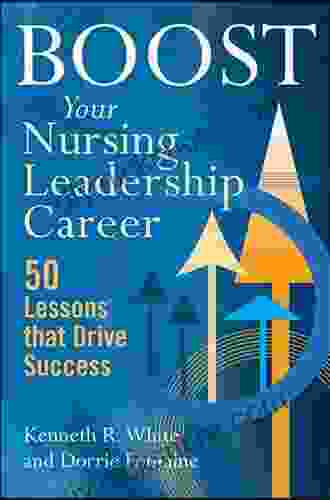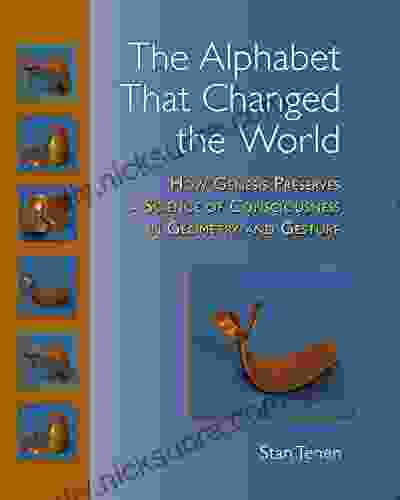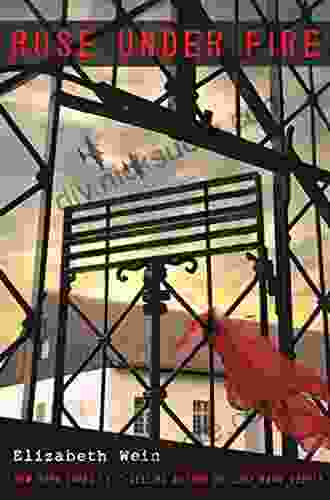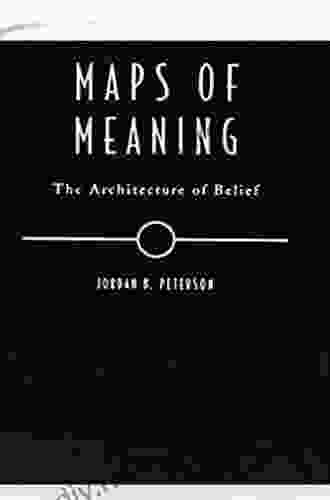Maps of Meaning: Navigating the Architecture of Belief

In his seminal work, "Maps of Meaning: The Architecture of Belief," cognitive scientist and philosopher Jordan Peterson embarked on an ambitious intellectual journey, delving into the depths of human cognition, mythology, and the nature of belief. This article offers a comprehensive exploration of Peterson's groundbreaking book, shedding light on its key concepts, implications, and enduring influence.
The Nature of Belief: Beyond Truth and Falsity
Central to Peterson's thesis is his exploration of belief as a fundamental aspect of human existence. He argues that beliefs are not merely intellectual propositions but rather complex, multi-faceted constructs that shape our perception of reality, motivate our actions, and provide a sense of order and purpose to our lives.
4.8 out of 5
| Language | : | English |
| File size | : | 56247 KB |
| Screen Reader | : | Supported |
| Print length | : | 564 pages |
Challenging simplistic notions of truth and falsity, Peterson proposes a nuanced understanding of belief. Beliefs are not simply "true" or "false" but rather more or less useful and coherent. Peterson emphasizes the practical implications of belief, arguing that it is the utility and effectiveness of a belief, rather than its strict adherence to objective truth, that ultimately determines its value.
The Architecture of Belief: Maps and Territories
To illustrate the intricate nature of belief, Peterson introduces the concept of "Maps of Meaning." These maps are not literal representations of reality but rather mental models or frameworks through which we navigate the world. Beliefs, in this sense, become the building blocks of these maps, shaping how we interpret our experiences and make sense of the complexities of life.
Peterson draws an analogy between maps and territories, emphasizing the distinction between the simplified representation and the complex reality it attempts to capture. Maps of Meaning, therefore, are not perfect representations of the world but rather approximations, subject to our own biases, limitations, and experiences.
Chaos, Order, and the Search for Meaning
Peterson's analysis of belief is inextricably linked to his exploration of chaos and order. He argues that the world is fundamentally chaotic and unpredictable, a realm of constant flux and uncertainty. However, humans have an innate drive to impose order on this chaos, to create structures and systems that make sense of our surroundings.
Beliefs play a crucial role in this process of creating order. They provide us with a sense of predictability and control, helping us navigate the complexities of life. Peterson emphasizes the importance of finding a balance between chaos and order, acknowledging both the necessity of structure and the need for flexibility and adaptability.
The Role of Mythology and Religion in Shaping Belief
Peterson draws heavily on mythology and religion to illustrate the evolution and significance of belief systems. He argues that these stories and rituals have played a profound role in shaping human culture, providing a framework for understanding the world and our place within it.
Through an exploration of ancient myths and religious teachings, Peterson highlights the universal patterns and themes that underlie human beliefs. He argues that these stories offer insights into the human psyche, revealing the archetypal fears, desires, and struggles that have shaped our collective consciousness.
The Importance of Individual Responsibility
While acknowledging the powerful influence of external factors on our beliefs, Peterson places great emphasis on individual responsibility. He challenges the notion of victimhood, asserting that we are ultimately responsible for the choices we make and the beliefs we hold.
Peterson encourages readers to take ownership of their beliefs, to critically examine them, and to make conscious decisions about how they shape their lives. He argues that by taking responsibility for our beliefs, we gain agency over our own destiny and create a more meaningful and fulfilling existence.
The Four Levels of Maps of Meaning
To better understand the complexity of belief systems, Peterson proposes a four-level model of Maps of Meaning:
- Simple Maps: Basic, concrete beliefs that provide rudimentary order to our immediate surroundings.
- Complex Maps: More abstract and elaborate beliefs that shape our understanding of the world and our place within it.
- Transcendent Maps: Beliefs that transcend the individual and connect us to something greater than ourselves.
- Mythological Maps: Universal, archetypal beliefs that provide a deep and meaningful understanding of human existence.
Implications and Applications
"Maps of Meaning" has had a profound impact on various fields, including psychology, philosophy, and even business. Its insights have been applied to areas such as:
- Personal Development: Understanding the role of belief in shaping our lives and empowering us to make positive changes.
- Leadership and Management: Navigating the complexities of human behavior and creating effective organizational cultures.
- Education and Social Change: Fostering critical thinking and facilitating meaningful conversations about the role of belief in society.
Jordan Peterson's "Maps of Meaning: The Architecture of Belief" is a challenging and thought-provoking work that has revolutionized our understanding of belief and its profound influence on human existence. Through an interdisciplinary approach, Peterson explores the nature of chaos and order, the power of mythology and religion, and the importance of individual responsibility in shaping our Maps of Meaning.
The book's insights have far-reaching implications for our understanding of ourselves, our relationships, and the world around us. It is a seminal work that continues to inspire and provoke intellectual discourse, challenging us to examine the foundations of our beliefs and to embark on a lifelong journey of meaning-making.
4.8 out of 5
| Language | : | English |
| File size | : | 56247 KB |
| Screen Reader | : | Supported |
| Print length | : | 564 pages |
Do you want to contribute by writing guest posts on this blog?
Please contact us and send us a resume of previous articles that you have written.
 Fiction
Fiction Non Fiction
Non Fiction Romance
Romance Mystery
Mystery Thriller
Thriller SciFi
SciFi Fantasy
Fantasy Horror
Horror Biography
Biography Selfhelp
Selfhelp Business
Business History
History Classics
Classics Poetry
Poetry Childrens
Childrens Young Adult
Young Adult Educational
Educational Cooking
Cooking Travel
Travel Lifestyle
Lifestyle Spirituality
Spirituality Health
Health Fitness
Fitness Technology
Technology Science
Science Arts
Arts Crafts
Crafts DIY
DIY Gardening
Gardening Petcare
Petcare Zen Faulkes
Zen Faulkes Gabrielle Coleman
Gabrielle Coleman Judi Garman
Judi Garman Adam Savage
Adam Savage A J Mackenzie
A J Mackenzie Jeff Kane
Jeff Kane Dane Huckelbridge
Dane Huckelbridge Steve Hindman
Steve Hindman Bruce Lansky
Bruce Lansky Peter Shelton
Peter Shelton Linh Phung
Linh Phung Katerina Griffith
Katerina Griffith Olivia Smith
Olivia Smith Rysa Walker
Rysa Walker Dirk F Moore
Dirk F Moore Crystal Cestari
Crystal Cestari Helen E Johnson
Helen E Johnson Cristian Salcescu
Cristian Salcescu John Williams
John Williams Filippo Coarelli
Filippo Coarelli Leigh Newman
Leigh Newman Christiane Kutik
Christiane Kutik Tammara Webber
Tammara Webber R A Mejia
R A Mejia Marks Prep
Marks Prep Dame Darcy
Dame Darcy Matilda Ramsay
Matilda Ramsay James Baldwin
James Baldwin Heather Gudenkauf
Heather Gudenkauf Eva Mauer
Eva Mauer Ken Alder
Ken Alder Lauren Muhlheim
Lauren Muhlheim Charles Szypszak
Charles Szypszak Garret Romaine
Garret Romaine Peter Goldenthal
Peter Goldenthal Ed Webster
Ed Webster Marlynn Jayme Schotland
Marlynn Jayme Schotland Joshua Akin
Joshua Akin Michael Dell
Michael Dell Steven Raichlen
Steven Raichlen Lindsey Vonn
Lindsey Vonn Karl Knopf
Karl Knopf A J Messenger
A J Messenger Kathy Koch
Kathy Koch William Scott Wilson
William Scott Wilson Vitaly Pedchenko
Vitaly Pedchenko Aaron Kleinmeyer
Aaron Kleinmeyer Rebecca A Moyes
Rebecca A Moyes Susan Aud Sonders
Susan Aud Sonders Lauren Oliver
Lauren Oliver Raymonde Carroll
Raymonde Carroll Jonathan Mckee
Jonathan Mckee A J Stewart
A J Stewart Kenay Keira
Kenay Keira Rafe Esquith
Rafe Esquith Zen Lylah
Zen Lylah Calvin L Chou
Calvin L Chou Val Emmich
Val Emmich Robert P Harris
Robert P Harris Polly Moore
Polly Moore Russell Sher
Russell Sher Tripp Bowden
Tripp Bowden Shenyang Guo
Shenyang Guo William Minto
William Minto Paul Mccarthy
Paul Mccarthy Christopher Small
Christopher Small Michael Labossiere
Michael Labossiere Ken Dryden
Ken Dryden Hazel Holmes
Hazel Holmes Gemma Milne
Gemma Milne Harry Yoon
Harry Yoon Barry Werth
Barry Werth Max Tegmark
Max Tegmark Alf Wilkinson
Alf Wilkinson Day Leitao
Day Leitao Adrian Dater
Adrian Dater Marcus Butler
Marcus Butler Scott A Ostrow
Scott A Ostrow Philip Golding
Philip Golding Patrick Meechan
Patrick Meechan Sadie Robertson Huff
Sadie Robertson Huff Arlin Smith
Arlin Smith Jec Aristotle Ballou
Jec Aristotle Ballou Jennifer Longmore
Jennifer Longmore Eileen Tracy
Eileen Tracy Rebecca Black
Rebecca Black William Bauer
William Bauer Andrew Henderson
Andrew Henderson David J Vanbergen Jr
David J Vanbergen Jr Lyndall Clipstone
Lyndall Clipstone Oba Ilari Aladokun
Oba Ilari Aladokun Brad K Chambers
Brad K Chambers Bob Plager
Bob Plager Hicham And Mohamed Ibnalkadi
Hicham And Mohamed Ibnalkadi Louis Jacques Dorais
Louis Jacques Dorais Jennifer N Smith
Jennifer N Smith Jennie Finch
Jennie Finch Akash Kapur
Akash Kapur Jonalu Johnstone
Jonalu Johnstone Jonathan Eig
Jonathan Eig Cynthia Ulrich Tobias
Cynthia Ulrich Tobias Dale Dougherty
Dale Dougherty Thomas Mcguane
Thomas Mcguane Jim Allen
Jim Allen Caspar Craven
Caspar Craven Amos Yong
Amos Yong Alexander Greenmaj
Alexander Greenmaj Mike Branon
Mike Branon Pintip Dunn
Pintip Dunn Cyndi Kinney
Cyndi Kinney John Mordechai Gottman
John Mordechai Gottman Sam Warburton
Sam Warburton John D Currid
John D Currid Gordon Macquarrie
Gordon Macquarrie Georgia Varozza
Georgia Varozza George Francis Dow
George Francis Dow Iasha King
Iasha King Stephen R Lawhead
Stephen R Lawhead Matthew J Friedman
Matthew J Friedman Todd Rose
Todd Rose A L Knorr
A L Knorr Tony Wright
Tony Wright Philip Yarrow
Philip Yarrow William Ramsey
William Ramsey Steve Angers
Steve Angers Elisabeth Fassas
Elisabeth FassasA G
 Dr Kevin Leman
Dr Kevin Leman Brian Clegg
Brian Clegg Susan Cooper
Susan Cooper Amanda Ostrander
Amanda Ostrander Helen Marot
Helen Marot Bear Heart
Bear Heart Michael Lanza
Michael Lanza Angela Himsel
Angela Himsel Zander Brumbaugh
Zander Brumbaugh Christine Wheeler
Christine Wheeler Jane Austen
Jane Austen Dmv Test Bank
Dmv Test Bank Tim Flanagan
Tim Flanagan Charles Butler
Charles Butler John L Parker Jr
John L Parker Jr Chuck Whelon
Chuck Whelon Randy Friedman
Randy Friedman Sky Marsen
Sky Marsen Micha Gorelick
Micha Gorelick Frost Kay
Frost Kay Daniel S Pierce
Daniel S Pierce William Monk
William Monk Lilith Mclelland
Lilith Mclelland Harrison Fluss
Harrison Fluss Dr Alan Whitcomb
Dr Alan Whitcomb Sarah Sutton
Sarah Sutton Andrea Falk
Andrea Falk Armin A Brott
Armin A Brott Paul Watzlawick
Paul Watzlawick Dr Tricia Groff
Dr Tricia Groff Seth M Holmes
Seth M Holmes A G Cairns Smith
A G Cairns Smith Blair Holden
Blair Holden Fernanda Pirie
Fernanda Pirie Kelly Starrett
Kelly Starrett Richard Heath
Richard Heath Noah Gift
Noah Gift Rens Bod
Rens Bod William C Oakes
William C Oakes Ray Ordorica
Ray Ordorica Cassandra Clare
Cassandra Clare Giordano Scalzo
Giordano Scalzo Kenneth Cline
Kenneth Cline Mia Kankimaki
Mia Kankimaki Tom Jordan
Tom Jordan Lou Tabory
Lou Tabory Joe Navarro
Joe Navarro A R Vasishtha
A R Vasishtha Rekha Ramcharan
Rekha Ramcharan Anghel Leonard
Anghel Leonard Peter Godfrey Smith
Peter Godfrey Smith Susan Striker
Susan Striker Thomas Hager
Thomas Hager Jamie Vardy
Jamie Vardy Catherine Rodgers
Catherine Rodgers Jennifer L Armentrout
Jennifer L Armentrout Pardha S Pyla
Pardha S Pyla Remy Agee
Remy Agee David H Barlow
David H Barlow Ilya Ru
Ilya Ru The R A
The R A Peter Nichols
Peter Nichols John Long
John Long Alex Karp
Alex Karp A M Wilson
A M Wilson Eric Blehm
Eric Blehm Emily Evans
Emily Evans Sherrilyn Kenyon
Sherrilyn Kenyon Taha Sochi
Taha Sochi Dale P Clemens
Dale P Clemens Dan Limbaugh
Dan Limbaugh Joseph Mctaggart
Joseph Mctaggart Thomas C Tabor
Thomas C Tabor Raymond M Smullyan
Raymond M Smullyan Catherine Stonehouse
Catherine Stonehouse Sarah Jo Brown
Sarah Jo Brown Larit Levy
Larit Levy Rick Telander
Rick Telander Rina Kent
Rina Kent Francis Pryor
Francis Pryor Jamal Moustafaev
Jamal Moustafaev Todd Downs
Todd Downs Chelsea Crockett
Chelsea Crockett Stan Skinner
Stan Skinner Chris Diamond
Chris Diamond A J Carlisle
A J Carlisle Val Mcdermid
Val Mcdermid Cathy A Malchiodi
Cathy A Malchiodi Russell Davis
Russell Davis Peter Maas
Peter Maas Stan Tenen
Stan Tenen Sonya Chappell
Sonya Chappell Din Daniels
Din Daniels Len Fisher
Len Fisher Bree Moore
Bree Moore Michael Lardon
Michael Lardon E S Wynn
E S Wynn Thomas R Martin
Thomas R Martin Tiara R Brown
Tiara R Brown Jack Grimshaw
Jack Grimshaw Shauna Lynn Panczyszyn
Shauna Lynn Panczyszyn Jon Gillespie Brown
Jon Gillespie Brown Natalie Pompilio
Natalie Pompilio Rebecca Pelky
Rebecca Pelky Meghan Leahy
Meghan Leahy Bob Frye
Bob Frye Sharie King
Sharie King A L Graziadei
A L Graziadei Todd Wanerman
Todd Wanerman A G Howard
A G Howard Certsquad Professional Trainers
Certsquad Professional Trainers Roxanne Martin
Roxanne Martin Susanne Foitzik
Susanne Foitzik Boston T Party
Boston T Party N J Enfield
N J Enfield Valerio Varesi
Valerio Varesi Dr Howard Rankin
Dr Howard Rankin David A Wells
David A Wells Joel David Hamkins
Joel David Hamkins Dr Stephanie Bloodworth Psyd
Dr Stephanie Bloodworth Psyd Jose M Forero Bautista
Jose M Forero Bautista Bill Jones
Bill Jones Scientia Media Group
Scientia Media Group Cath Smith
Cath Smith Leslie Stager
Leslie Stager Helen Buckley
Helen Buckley Toni Natalie
Toni Natalie David Deutsch
David Deutsch Charles Edward Chapel
Charles Edward Chapel Lisa Pease
Lisa Pease Mitch Landrieu
Mitch Landrieu Kevin Adams
Kevin Adams Tsao Lin E Moy L Ac Msom
Tsao Lin E Moy L Ac Msom Heather Anderson
Heather Anderson John Halligan
John Halligan John L Messina
John L Messina Abigail Burd Lcsw Pmh C
Abigail Burd Lcsw Pmh C Alison Cotter
Alison Cotter Rachael Allen
Rachael Allen Yasu
Yasu Linda Tuhiwai Smith
Linda Tuhiwai Smith Peter Zheutlin
Peter Zheutlin Karla Helbert
Karla Helbert Sandra Niche
Sandra Niche Diane Burke Fessler
Diane Burke Fessler Lillian Tibbles Phd
Lillian Tibbles Phd John Brenkus
John Brenkus Joe Pepitone
Joe Pepitone A K Davidson
A K Davidson Jm Mason
Jm Mason Jan Morris
Jan Morris Shelly Mazzanoble
Shelly Mazzanoble Ari Tuckman
Ari Tuckman Walter Dean Myers
Walter Dean Myers Corina Morariu
Corina Morariu Okina Baba
Okina Baba Anna Goldsworthy
Anna Goldsworthy Bob Trueman
Bob Trueman King Solomon
King Solomon Mark Obmascik
Mark Obmascik Virginia Willis
Virginia Willis Francis Fukuyama
Francis Fukuyama Kerri Hummingbird Sami
Kerri Hummingbird Sami Ray Bradbury
Ray Bradbury Nick Jackson
Nick Jackson Todd Gitlin
Todd Gitlin Dan Romanchik Kb6nu
Dan Romanchik Kb6nu Pete Ripmaster
Pete Ripmaster Niall Ferguson
Niall Ferguson Bryan Berg
Bryan Berg Lilin Yang
Lilin Yang Watt Key
Watt Key Monte Burke
Monte Burke Freya Hoffmeister
Freya Hoffmeister Erin Watt
Erin Watt Raymond J Carroll
Raymond J Carroll William F Mann
William F Mann Andreas Quast
Andreas Quast Ken Castor
Ken Castor Roger Zelazny
Roger Zelazny Lucy Christopher
Lucy Christopher Jim Vernes
Jim Vernes Chris I Naylor
Chris I Naylor A J Hamler
A J Hamler W Timothy Gallwey
W Timothy Gallwey Eric Sevareid
Eric Sevareid Jonathan S Rose
Jonathan S Rose Matthieu Ricard
Matthieu Ricard Mrjamvad
Mrjamvad Katrina Abbott
Katrina Abbott Michael D Coogan
Michael D Coogan Rosie Garthwaite
Rosie Garthwaite Carrie Harper
Carrie Harper Kenn Bivins
Kenn Bivins Eric Armstrong
Eric Armstrong A Roger Ekirch
A Roger Ekirch Nicole Conway
Nicole Conway Lindsey Lapointe
Lindsey Lapointe Sean Skahan
Sean Skahan Tanya Selvaratnam
Tanya Selvaratnam Don Fink
Don Fink Roy Richard Grinker
Roy Richard Grinker Alyssa Padgett
Alyssa Padgett Josh Skeen
Josh Skeen Shanterra Mcbride
Shanterra Mcbride Vernon Trafford
Vernon Trafford Dawn Huebner
Dawn Huebner Cailin O Connor
Cailin O Connor Lou Zambello
Lou Zambello A F Stewart
A F Stewart Upton Sinclair
Upton Sinclair John Almberg
John Almberg Eugene Don
Eugene Don Helen Fitzgerald
Helen Fitzgerald Gary Gruber
Gary Gruber Anji Andrews
Anji Andrews Michelle Maccarthy
Michelle Maccarthy Bruce Tremper
Bruce Tremper Saxton Pope
Saxton Pope Mj Porter
Mj Porter Timothy J Gawne
Timothy J Gawne Sergey Kosarevsky
Sergey Kosarevsky Barbara J Bain
Barbara J Bain Flo Perry
Flo Perry David G Taylor
David G Taylor Megan Vickers
Megan Vickers Ridge Magee
Ridge Magee David Remnick
David Remnick Anne Deans
Anne Deans A J Angulo
A J Angulo Kenneth Cloke
Kenneth Cloke Dave Lowry
Dave Lowry David Spiegelhalter
David Spiegelhalter Businessnews Publishing
Businessnews Publishing Soap2day Publication
Soap2day Publication Mandy Rivers
Mandy Rivers Manoush Zomorodi
Manoush Zomorodi Kathlyn Gay
Kathlyn Gay Jennifer Trainer Thompson
Jennifer Trainer Thompson Winston Starr
Winston Starr Bruce Collier
Bruce Collier A J Mackinnon
A J Mackinnon Dean R Johnson
Dean R Johnson Sherine Hamdy
Sherine Hamdy Jean Philippe Dionne
Jean Philippe Dionne Marc S Sabatine
Marc S Sabatine Mike Tidwell
Mike Tidwell Mark Ryan
Mark Ryan A H Almaas
A H Almaas Nancy Mckenzie
Nancy Mckenzie Lisa Murphy
Lisa Murphy Anne Sigismund Huff
Anne Sigismund Huff Glenn Patron
Glenn Patron Jennifer Senior
Jennifer Senior Sandra Swenson
Sandra Swenson David Magee
David Magee Grady Hendrix
Grady Hendrix Homeira Qaderi
Homeira Qaderi Byron Pitts
Byron Pitts Jordan B Peterson
Jordan B Peterson Peter Rees
Peter Rees A M Strickland
A M Strickland Ryan Gray
Ryan Gray Laura Pohl
Laura Pohl Anthony J Onwuegbuzie
Anthony J Onwuegbuzie Loretta Sponsler
Loretta Sponsler Michael Shingleton
Michael Shingleton Lyla Lee
Lyla Lee Matt Brown
Matt Brown Leandro Taub
Leandro Taub Diane Stresing
Diane Stresing Timothy C Urdan
Timothy C Urdan K A Riley
K A Riley
Light bulbAdvertise smarter! Our strategic ad space ensures maximum exposure. Reserve your spot today!

 Jorge AmadoElectronics for Biologists: A Comprehensive Guide to Electrical Engineering...
Jorge AmadoElectronics for Biologists: A Comprehensive Guide to Electrical Engineering...
 Easton PowellSuggestions For High School And College Students Chicago Guides To Academic...
Easton PowellSuggestions For High School And College Students Chicago Guides To Academic...
 Robert Louis StevensonBoost Your Nursing Leadership Career: A Comprehensive Guide to Advance Your...
Robert Louis StevensonBoost Your Nursing Leadership Career: A Comprehensive Guide to Advance Your...
 Henry GreenGet Off The Infertility Emotional Rollercoaster And Fast Track Your Journey...
Henry GreenGet Off The Infertility Emotional Rollercoaster And Fast Track Your Journey... Anthony BurgessFollow ·15.9k
Anthony BurgessFollow ·15.9k Stephen FosterFollow ·4.1k
Stephen FosterFollow ·4.1k Ernest PowellFollow ·10.9k
Ernest PowellFollow ·10.9k Haruki MurakamiFollow ·12k
Haruki MurakamiFollow ·12k Ervin BellFollow ·17.3k
Ervin BellFollow ·17.3k Galen PowellFollow ·7.4k
Galen PowellFollow ·7.4k Ibrahim BlairFollow ·3.5k
Ibrahim BlairFollow ·3.5k Sam CarterFollow ·17.4k
Sam CarterFollow ·17.4k

 Franklin Bell
Franklin BellHow Genesis Preserves Science Of Consciousness In...
The book of Genesis is...

 Ted Simmons
Ted SimmonsAt Day's Close, Night in Times Past
As the sun dips...

 Kenneth Parker
Kenneth ParkerRose Under Fire: Code Name Verity - A Heartbreaking and...
In the annals of...

 Jerry Hayes
Jerry HayesNurturing Massage for Pregnancy: A Comprehensive Guide to...
Pregnancy is...

 Blake Bell
Blake BellFill in the Blank: Word Kind of Animal Farm for Kids and...
This interactive fill-in-the-blank...
4.8 out of 5
| Language | : | English |
| File size | : | 56247 KB |
| Screen Reader | : | Supported |
| Print length | : | 564 pages |






